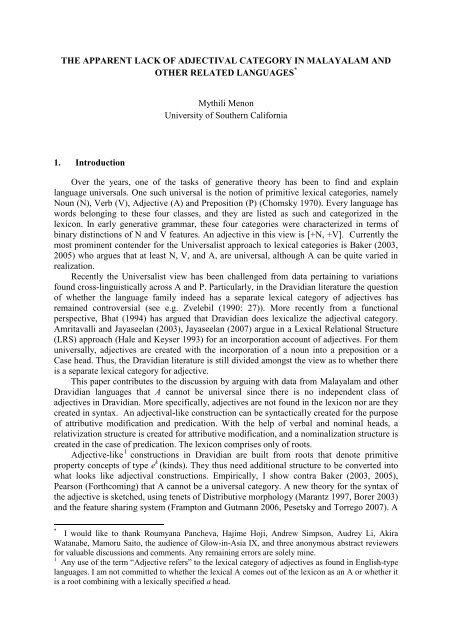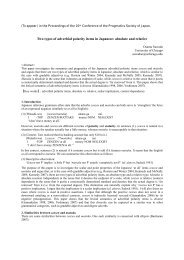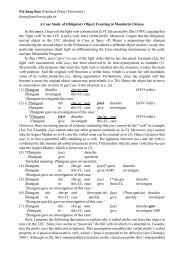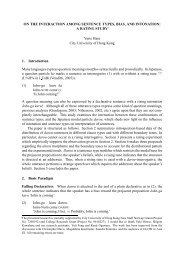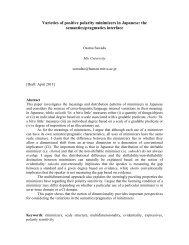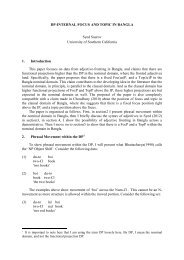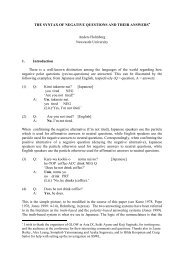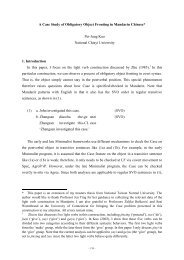The Apparent Lack of Adjectival Category in Malayalam and Other ...
The Apparent Lack of Adjectival Category in Malayalam and Other ...
The Apparent Lack of Adjectival Category in Malayalam and Other ...
Create successful ePaper yourself
Turn your PDF publications into a flip-book with our unique Google optimized e-Paper software.
THE APPARENT LACK OF ADJECTIVAL CATEGORY IN MALAYALAM AND<br />
OTHER RELATED LANGUAGES *<br />
Mythili Menon<br />
University <strong>of</strong> Southern California<br />
1. Introduction<br />
Over the years, one <strong>of</strong> the tasks <strong>of</strong> generative theory has been to f<strong>in</strong>d <strong>and</strong> expla<strong>in</strong><br />
language universals. One such universal is the notion <strong>of</strong> primitive lexical categories, namely<br />
Noun (N), Verb (V), Adjective (A) <strong>and</strong> Preposition (P) (Chomsky 1970). Every language has<br />
words belong<strong>in</strong>g to these four classes, <strong>and</strong> they are listed as such <strong>and</strong> categorized <strong>in</strong> the<br />
lexicon. In early generative grammar, these four categories were characterized <strong>in</strong> terms <strong>of</strong><br />
b<strong>in</strong>ary dist<strong>in</strong>ctions <strong>of</strong> N <strong>and</strong> V features. An adjective <strong>in</strong> this view is [+N, +V]. Currently the<br />
most prom<strong>in</strong>ent contender for the Universalist approach to lexical categories is Baker (2003,<br />
2005) who argues that at least N, V, <strong>and</strong> A, are universal, although A can be quite varied <strong>in</strong><br />
realization.<br />
Recently the Universalist view has been challenged from data perta<strong>in</strong><strong>in</strong>g to variations<br />
found cross-l<strong>in</strong>guistically across A <strong>and</strong> P. Particularly, <strong>in</strong> the Dravidian literature the question<br />
<strong>of</strong> whether the language family <strong>in</strong>deed has a separate lexical category <strong>of</strong> adjectives has<br />
rema<strong>in</strong>ed controversial (see e.g. Zvelebil (1990: 27)). More recently from a functional<br />
perspective, Bhat (1994) has argued that Dravidian does lexicalize the adjectival category.<br />
Amritavalli <strong>and</strong> Jayaseelan (2003), Jayaseelan (2007) argue <strong>in</strong> a Lexical Relational Structure<br />
(LRS) approach (Hale <strong>and</strong> Keyser 1993) for an <strong>in</strong>corporation account <strong>of</strong> adjectives. For them<br />
universally, adjectives are created with the <strong>in</strong>corporation <strong>of</strong> a noun <strong>in</strong>to a preposition or a<br />
Case head. Thus, the Dravidian literature is still divided amongst the view as to whether there<br />
is a separate lexical category for adjective.<br />
This paper contributes to the discussion by argu<strong>in</strong>g with data from <strong>Malayalam</strong> <strong>and</strong> other<br />
Dravidian languages that A cannot be universal s<strong>in</strong>ce there is no <strong>in</strong>dependent class <strong>of</strong><br />
adjectives <strong>in</strong> Dravidian. More specifically, adjectives are not found <strong>in</strong> the lexicon nor are they<br />
created <strong>in</strong> syntax. An adjectival-like construction can be syntactically created for the purpose<br />
<strong>of</strong> attributive modification <strong>and</strong> predication. With the help <strong>of</strong> verbal <strong>and</strong> nom<strong>in</strong>al heads, a<br />
relativization structure is created for attributive modification, <strong>and</strong> a nom<strong>in</strong>alization structure is<br />
created <strong>in</strong> the case <strong>of</strong> predication. <strong>The</strong> lexicon comprises only <strong>of</strong> roots.<br />
Adjective-like 1 constructions <strong>in</strong> Dravidian are built from roots that denote primitive<br />
property concepts <strong>of</strong> type e k (k<strong>in</strong>ds). <strong>The</strong>y thus need additional structure to be converted <strong>in</strong>to<br />
what looks like adjectival constructions. Empirically, I show contra Baker (2003, 2005),<br />
Pearson (Forthcom<strong>in</strong>g) that A cannot be a universal category. A new theory for the syntax <strong>of</strong><br />
the adjective is sketched, us<strong>in</strong>g tenets <strong>of</strong> Distributive morphology (Marantz 1997, Borer 2003)<br />
<strong>and</strong> the feature shar<strong>in</strong>g system (Frampton <strong>and</strong> Gutmann 2006, Pesetsky <strong>and</strong> Torrego 2007). A<br />
*<br />
I would like to thank Roumyana Pancheva, Hajime Hoji, Andrew Simpson, Audrey Li, Akira<br />
Watanabe, Mamoru Saito, the audience <strong>of</strong> Glow-<strong>in</strong>-Asia IX, <strong>and</strong> three anonymous abstract reviewers<br />
for valuable discussions <strong>and</strong> comments. Any rema<strong>in</strong><strong>in</strong>g errors are solely m<strong>in</strong>e.<br />
1 Any use <strong>of</strong> the term “Adjective refers” to the lexical category <strong>of</strong> adjectives as found <strong>in</strong> English-type<br />
languages. I am not committed to whether the lexical A comes out <strong>of</strong> the lexicon as an A or whether it<br />
is a root comb<strong>in</strong><strong>in</strong>g with a lexically specified a head.
<strong>The</strong> Proceed<strong>in</strong>gs <strong>of</strong> GLOW <strong>in</strong> Asia IX<br />
desired consequence <strong>of</strong> the new system is the result obta<strong>in</strong>ed for case assignment <strong>and</strong><br />
agreement morphology. It expla<strong>in</strong>s the dative/nom<strong>in</strong>ative case alternation <strong>in</strong> predicative<br />
constructions <strong>in</strong> Dravidian. Some <strong>of</strong> the consequences <strong>of</strong> the theory <strong>in</strong>clude the presence <strong>of</strong><br />
only nom<strong>in</strong>al <strong>and</strong> verbal comparatives, <strong>and</strong> the absence <strong>of</strong> resultative secondary predications<br />
<strong>in</strong> Dravidian.<br />
<strong>The</strong> paper is organized as follows. In the next section I will look at the status <strong>of</strong><br />
adjectives <strong>in</strong> Korean, Japanese, <strong>and</strong> some Bantu languages. In § 3.0, I will then <strong>in</strong>troduce the<br />
basic paradigm concentrat<strong>in</strong>g on data from <strong>Malayalam</strong>. In § 4.0, the analysis will be sketched<br />
by crucially look<strong>in</strong>g at the semantics <strong>and</strong> the syntactic representations. In § 5.0, I will address<br />
the residual issues <strong>and</strong> problems to be addressed for future research <strong>and</strong> conclude.<br />
2. Miss<strong>in</strong>g Attributive Adjectives <strong>in</strong> Japanese <strong>and</strong> <strong>Other</strong> Languages<br />
One <strong>of</strong> the canonical positions <strong>in</strong> which an adjective can appear is the attributive position.<br />
It is known that <strong>in</strong> some languages, attributive adjectives are miss<strong>in</strong>g. Japanese, Korean, Slave,<br />
Ika, <strong>and</strong> other Bantu languages belong to this category. In Japanese, which we turn to<br />
presently, the status <strong>of</strong> adjectives is as controversial as it is <strong>in</strong> the Dravidian literature. Korean<br />
attributive adjectives have been argued to be concealed relative clauses (Kim 2002). In Slave,<br />
adjectives appear predicatively but not <strong>in</strong> the attributive position unless relativized. In Ika, the<br />
use <strong>of</strong> a copular verbal element mediates the presence <strong>of</strong> the adjective <strong>in</strong> the attributive<br />
positions. Where then are the miss<strong>in</strong>g attributive adjectives?<br />
2.1. Japanese Adjectives<br />
<strong>The</strong> status <strong>of</strong> Japanese adjectives is controversial. <strong>The</strong>re are two k<strong>in</strong>ds <strong>of</strong> adjectives<br />
discussed <strong>in</strong> the literature. <strong>The</strong> first one is called the true adjective (Miyagawa 1987,<br />
Murasagi 1990) <strong>and</strong> <strong>in</strong> Chomsky’s (1970) terms is categorized as [+N, +V]. <strong>The</strong> other<br />
category comprises <strong>of</strong> the “verbal adjective” which is categorized as +V.<br />
(1) True Adjective Verbal Adjective<br />
a. Kirei ‘beautiful’ b. Utsukushi ‘beautiful’<br />
It is <strong>of</strong>ten assumed that the adjectives belong<strong>in</strong>g to (1a) can appear as attributive<br />
modifiers without the help <strong>of</strong> any additional morphology. Verbal adjectives, on the other h<strong>and</strong>,<br />
can appear only with the help <strong>of</strong> a copula <strong>in</strong> the attributive position.<br />
(2) utsukushi-*(i) onna Japanese<br />
beautiful-PRES woman<br />
Baker (2003) notes that the presence <strong>of</strong> the copular element makes (2) a relative clause<br />
structure <strong>and</strong> –i does not signal an attributive modifier. However, he wishes to ma<strong>in</strong>ta<strong>in</strong> the<br />
view that (1b) type verbal adjectives <strong>in</strong> fact behave like attributive modifiers <strong>and</strong> are not<br />
similar to the characteristic functions <strong>of</strong> verbs. <strong>The</strong> diagnostics <strong>in</strong>clude resultative secondary<br />
predications (RSPs), the complement position <strong>of</strong> a degree word such as ‘too’, ‘as’, <strong>and</strong><br />
unaccusativity predicates. In English, only adjectives can appear <strong>in</strong> RSPs. Nouns <strong>and</strong> verbs<br />
are unable to do so.<br />
(3) a. I beat the metal flat (AP)<br />
b. * I beat the metal broke (VP)<br />
c. * I beat the metal (a) sword (NP)
<strong>The</strong> <strong>Apparent</strong> <strong>Lack</strong> <strong>of</strong> <strong>Adjectival</strong> <strong>Category</strong> <strong>in</strong> <strong>Malayalam</strong> <strong>and</strong> <strong>Other</strong> Related Lanugages (M. Menon)<br />
Utsukushi-type adjectives can appear <strong>in</strong> RSPs suggest<strong>in</strong>g they are adjective-like <strong>in</strong> their<br />
behavior <strong>and</strong> unlike verbs <strong>in</strong> that sense (Ohkado 1991, Washio 1997).<br />
(4) a. Taroo-ga kami-o mizika-ku kit-ta.<br />
Taro-NOM hair-ACC short-AFF cut-PST<br />
‘Taro cut the hair short.’<br />
b. # Taroo-ga kami-o ochi(-te) kit-ta<br />
Taro-NOM hair-ACC fall-AFF cut-PST<br />
‘Taro cut the hair so that it fell.’<br />
In English, the complement position <strong>of</strong> dedicated degree words such as ‘too’ <strong>and</strong> ‘as’<br />
necessarily has to be occupied by an adjective. Similarly, Utsukushi-type adjectives can<br />
appear <strong>in</strong> the complement position <strong>of</strong> a degree word suggest<strong>in</strong>g their behavior is unlike that <strong>of</strong><br />
verbs.<br />
(5) a. Mary is too smart (to make such a mistake).<br />
b. * Mary is too (a) genius (to make such a mistake).<br />
(6) a. Hanako-ga totemo utsukusi-i. (A)<br />
Hanako-NOM very beautiful-PRES.<br />
‘Hanako is very beautiful.’<br />
b. * Hanako-ga totemo sensei-da. (N)<br />
Hanako-NOM very teacher-COP<br />
‘Hanako is very (much a) teacher.’<br />
c. * Hanako-ga totemo okasi-o tabe-ru. (V)<br />
Hanako-NOM very sweets-ACC eat-PRES<br />
‘Hanako very (much) eats sweets.’<br />
A po<strong>in</strong>t however which Baker (2003) does not make is the fact that even (1a) needs the<br />
presence <strong>of</strong> a particle (<strong>in</strong> traditional grammar this could be a copula 2 ) to obligatorily be<br />
present <strong>in</strong> order for the adjective to attributively modify a noun. Thus, for our purposes it is<br />
important to note that without the mediation <strong>of</strong> an extra particle, attributive modification is<br />
not possible for either type <strong>of</strong> adjective <strong>in</strong> Japanese.<br />
(7) Kirei-*(na) onna Japanese<br />
beautiful-PRT woman<br />
‘Beautiful woman’<br />
Similar to the claims for Japanese, Korean too admits only a relative clause structure <strong>in</strong><br />
the attributive position (Kim 2002). Traditionally, however, Korean has been analyzed as<br />
hav<strong>in</strong>g adjectives but as seen <strong>in</strong> (8) the adjective is realized as a participial form <strong>and</strong> the<br />
relative clause marker attaches to the entire constituent.<br />
(8) Ce [ e 1 yeppu-ess]-ten 1 yeca Korean<br />
that [ pretty-PRT]-REL woman<br />
'that woman who used to be/was pretty'<br />
Slave <strong>and</strong> Ika (belong<strong>in</strong>g to the Athapaskan language family) also admit adjectives <strong>in</strong><br />
the attributive position only if there is an obligatory copula present on the adjective.<br />
2 Hajime Hoji p.c.
<strong>The</strong> Proceed<strong>in</strong>gs <strong>of</strong> GLOW <strong>in</strong> Asia IX<br />
(9) a. Yenene (be-gho) sho hili Slave<br />
woman v3-<strong>of</strong> proud/happy 3-is<br />
‘<strong>The</strong> woman is happy/proud (<strong>of</strong> him/her).’<br />
b. aná?nuga [awΛn? *(kawa)] guákΛ-ža Ika<br />
animal big seem kill-MED<br />
‘It kills big animals.’<br />
We have seen that languages can resist attributive modification for adjectives. In<br />
<strong>Malayalam</strong> <strong>and</strong> other Dravidian languages, neither can an adjective occur <strong>in</strong> the attributive<br />
position nor <strong>in</strong> the predicative position, to which I turn to presently.<br />
3. <strong>The</strong> Basic Paradigm <strong>in</strong> <strong>Malayalam</strong><br />
<strong>The</strong>re are two classes <strong>of</strong> roots <strong>in</strong> <strong>Malayalam</strong> that look adjectival, <strong>in</strong> that they participate<br />
<strong>in</strong> positions <strong>in</strong> which English would have an adjective - Class1 or Relativiz<strong>in</strong>g roots <strong>and</strong><br />
Class2 or Nom<strong>in</strong>aliz<strong>in</strong>g roots. A brief look <strong>in</strong>to the history <strong>of</strong> these roots suggests that Class1<br />
roots had a verbal orig<strong>in</strong> (See Jayaseelan 2007) <strong>and</strong> could be deverbal (as suggested <strong>in</strong><br />
An<strong>and</strong>an 1985). Class2 roots are borrowed roots, mostly from Sanskrit.<br />
(10) Class 1 (-a end<strong>in</strong>g relativized roots)<br />
valiya ‘big’, ceriya ‘small’, puthiya ‘new’, nalla ‘good’, pacca ‘green’, velutta ‘white’,<br />
maɳɳa ‘yellow’, pazhaya ‘old’<br />
(11) Class 2 (-am end<strong>in</strong>g nom<strong>in</strong>alized roots)<br />
santosham ‘happ<strong>in</strong>ess’, sankatam ‘sadness’, prayasam ‘difficulty’, pokkam ‘tallness’,<br />
bedham ‘better’, madhuram ‘sweetness’<br />
<strong>The</strong> forms belong<strong>in</strong>g to Class1 roots all end <strong>in</strong> –a which is also the Proto-Dravidian<br />
relative clause marker derived from a shorten<strong>in</strong>g <strong>of</strong> the distal determ<strong>in</strong>er aa ‘that’.<br />
(12) a. pazhay-a ‘that which is old’ Tamil, <strong>Malayalam</strong><br />
b. p-a ‘that which is old’ Kodagu, Todi<br />
c. par-a ‘that which is old’ Tulu<br />
d. hos-a ‘that which is new’ Kannada, Tulu<br />
e. pedd-a ‘that which is great’ Telugu<br />
<strong>The</strong> idea that words found <strong>in</strong> the Class1 category are reduced relative clauses was first<br />
suggested by An<strong>and</strong>an (1985). <strong>The</strong> Class2 roots are borrowed mostly from Sanskrit 3 .<br />
<strong>Malayalam</strong> has a phonological restriction on the coda position <strong>of</strong> a syllable. <strong>The</strong> only sounds<br />
that can appear <strong>in</strong> this position are vowels <strong>and</strong> the bilabial nasal /m/ <strong>and</strong> the alveolar nasal /n/ 4 .<br />
Notice that the Sanskrit roots <strong>in</strong> Class2 mostly end <strong>in</strong> an obstruent. This phonological coda<br />
restriction entails that the nom<strong>in</strong>al morpheme –am is employed to turn the Class2 roots <strong>in</strong>to<br />
someth<strong>in</strong>g more native-like. <strong>Malayalam</strong> also has a nom<strong>in</strong>alizer atə which is used to<br />
nom<strong>in</strong>alize only clauses or verbal elements as we will see below.<br />
<strong>The</strong> Class1 roots can undergo nom<strong>in</strong>alization with the nom<strong>in</strong>aliz<strong>in</strong>g morpheme atə<br />
whereas Class2 roots cannot, s<strong>in</strong>ce they are already nom<strong>in</strong>als; neither can they be relativized<br />
us<strong>in</strong>g the -a marker.<br />
3 Among the Dravidian languages, <strong>Malayalam</strong> borrowed the most from Sanskrit <strong>and</strong> Tamil resisted<br />
Sanksritization.<br />
4 Even though <strong>Malayalam</strong> has the maximum number <strong>of</strong> nasals <strong>in</strong> any Indian language, only these two<br />
nasals can occur <strong>in</strong> the coda position.
<strong>The</strong> <strong>Apparent</strong> <strong>Lack</strong> <strong>of</strong> <strong>Adjectival</strong> <strong>Category</strong> <strong>in</strong> <strong>Malayalam</strong> <strong>and</strong> <strong>Other</strong> Related Lanugages (M. Menon)<br />
(13) a. valiy-atə ceriy-atə b. * valiya-am *ceriya-am<br />
big-NOML small-NOML big-NOML small-NOML<br />
c. * santosham-a *sankatam-a d. * santosham-atə *sankatam-atə<br />
happ<strong>in</strong>ess-REL sadness-REL happ<strong>in</strong>ess-NOML sadness-NOML<br />
In the next section, I will look at the distribution <strong>of</strong> the Class1 roots <strong>and</strong> Class2 roots<br />
look<strong>in</strong>g specifically at the attributive <strong>and</strong> the predicative positions.<br />
3.1. Distribution <strong>of</strong> Class1 <strong>and</strong> Class2 Roots<br />
<strong>The</strong> Class1 <strong>and</strong> the Class2 roots display different syntactic behavior. Relativized Class1<br />
roots can appear <strong>in</strong> attributive positions whereas Class2 roots can appear <strong>in</strong> attributive<br />
positions only with the mediation <strong>of</strong> a non-f<strong>in</strong>ite copula (uLL, the verb ‘to exist’) <strong>and</strong> the<br />
relative marker –a.<br />
(14) a. valiya kutti [Class1]<br />
big child<br />
‘Big child’ (Lit: child be<strong>in</strong>g big)<br />
b. santosham uLLa kutti [Class2]<br />
happy COP-REL child<br />
‘Happy child’(Lit: child (to whom) there be<strong>in</strong>g happ<strong>in</strong>ess)<br />
This strategy is also found <strong>in</strong> other languages such as Wol<strong>of</strong> as reported by McLaughl<strong>in</strong><br />
(2004) <strong>and</strong> Slave <strong>and</strong> Ika as discussed above. <strong>The</strong> relative clause marker <strong>in</strong> Wol<strong>of</strong> is /Cu/<br />
where C is a noun class marker which shows concord with the noun.<br />
(15) a. xale bu rafet Wol<strong>of</strong><br />
child REL pretty<br />
‘A pretty child’<br />
b. xale bu xam<br />
child REL know<br />
‘A child who knows’<br />
<strong>The</strong> use <strong>of</strong> the non-f<strong>in</strong>ite copula ties <strong>in</strong> with the fact that relative clauses <strong>in</strong> <strong>Malayalam</strong><br />
are non-f<strong>in</strong>ite (See Jayaseelan 2011 for a detailed analysis). A question begs itself at this po<strong>in</strong>t,<br />
why can’t the relative clause marker attach directly to the borrowed roots, i.e. why doesn’t the<br />
language allow words as <strong>in</strong> (16).<br />
(16) a. * pokk-a ‘tall’<br />
b. * santosh-a ‘happ<strong>in</strong>ess’ 5<br />
If both Class1 <strong>and</strong> Class2 roots are identical then what makes the relative clause marker<br />
attach only to certa<strong>in</strong> roots? Class2 roots as we saw before are borrowed roots. Moreover<br />
there is no prohibition <strong>in</strong> a word end<strong>in</strong>g <strong>in</strong> a vowel (as Class1 illustrates). <strong>The</strong> answer lies <strong>in</strong><br />
5 Interest<strong>in</strong>gly, this form is attested only <strong>in</strong> one usage- the ‘Happy birthday’ equivalent <strong>in</strong> <strong>Malayalam</strong><br />
which is:<br />
(i) santoshajanmad<strong>in</strong>am kutti-kkə<br />
happy born day child-DAT<br />
‘Happy birthday to the child’<br />
Presumably, this is because ‘santoshajanmad<strong>in</strong>am’ is a compound <strong>and</strong> the /m/ <strong>in</strong> the coda <strong>of</strong><br />
‘santosham’ is deleted.
<strong>The</strong> Proceed<strong>in</strong>gs <strong>of</strong> GLOW <strong>in</strong> Asia IX<br />
the patterns exhibited by the two classes <strong>of</strong> roots. <strong>The</strong> morphology module admits both the<br />
relativization <strong>and</strong> nom<strong>in</strong>alization as routes to realiz<strong>in</strong>g an adjectival mean<strong>in</strong>g. <strong>The</strong> Class1<br />
roots are deverbal, the Class2 roots are not. –a is always look<strong>in</strong>g for a verbal element. Class2<br />
roots are borrowed <strong>and</strong> upon borrow<strong>in</strong>g has to undergo the nom<strong>in</strong>al morphology prior to the –<br />
a suffixation.<br />
<strong>The</strong> fact that –a is always look<strong>in</strong>g for a verbal element is exemplified <strong>in</strong> the attributive<br />
position <strong>of</strong> the Class2 adjective, they always need the non-f<strong>in</strong>ite copula as support for the –a<br />
attachment. –a attaches to verbs <strong>and</strong> never to nouns.<br />
(17) a. [njaan ___ kaNT-a] kutti<br />
I see-REL child<br />
‘<strong>The</strong> child that I saw’<br />
b. [[njaan ___ kaNT-u ennə] n<strong>in</strong>gal parayunn-a] kutti<br />
I see-PAST COMP you say-REL child<br />
‘<strong>The</strong> child that you say that I saw’<br />
In English, the relativizers move from an argument position to a non-argument position.<br />
<strong>The</strong> <strong>Malayalam</strong> –a is different <strong>in</strong> that respect. <strong>The</strong> behavior <strong>of</strong> –a is different from the English<br />
‘who’ <strong>in</strong> that –a does not open up any argument positions. –a does not contribute anyth<strong>in</strong>g<br />
semantically, s<strong>in</strong>ce the root has already been changed <strong>in</strong>to an with a null verbal head <strong>in</strong><br />
the case <strong>of</strong> Class1 <strong>and</strong> by the overt non-f<strong>in</strong>ite copula <strong>in</strong> Class2 as we will see <strong>in</strong> the next<br />
section.<br />
Neither Class1 nor Class2 roots can appear as predicative modifiers unless they are<br />
nom<strong>in</strong>alized. Class1 roots appear <strong>in</strong> relative clauses, which now modify a pronom<strong>in</strong>al. This is<br />
seen by the number <strong>and</strong> gender mark<strong>in</strong>g on the relativized Class1 root that comb<strong>in</strong>es with the<br />
so-called equative copula, whereas Class2 roots can appear as the complement <strong>of</strong> an<br />
existential copula trigger<strong>in</strong>g the appearance <strong>of</strong> dative case on the subject/experiencer.<br />
(18) a. avan nalla-van aaNə b. avaL nalla-vaL aaNə [Class1]<br />
he good-M.SG EQ she good-F.SG EQ<br />
‘He is good’ (Lit: he is one be<strong>in</strong>g good) ‘She is good’ (Lit: she is one be<strong>in</strong>g good)<br />
(19) a. avan-ə pokkam uNTə b. kutti-kkə dukham uNTə [Class2]<br />
he-DAT tall EX child-DAT sad EX<br />
‘He is tall’ (Lit: to him there is tallness) ‘<strong>The</strong> child is sad’ (Lit: to the child there<br />
is sadness)<br />
Class1 <strong>and</strong> Class2 appear <strong>in</strong> predicative positions with different copulas. While Class1<br />
uses the equative copula aaNə, Class2 uses the existential copula uNTə. While <strong>in</strong> Class1 roots,<br />
there is the appearance <strong>of</strong> the nom<strong>in</strong>alization morphemes adher<strong>in</strong>g to the number <strong>and</strong> gender<br />
features <strong>of</strong> the subject <strong>and</strong> the subject appears <strong>in</strong> nom<strong>in</strong>ative case. Class2 are nom<strong>in</strong>als to<br />
beg<strong>in</strong> with, hence, there is no reappearance <strong>of</strong> the nom<strong>in</strong>al markers found <strong>in</strong> (18). <strong>The</strong><br />
strategy that is at use here is what I call the ‘possessive strategy’. <strong>The</strong> dative case <strong>in</strong> (19)<br />
exemplifies this overtly. <strong>The</strong> mean<strong>in</strong>g is ak<strong>in</strong> to say<strong>in</strong>g the subject ‘he’ possesses ‘tallness’ or<br />
‘height’. <strong>The</strong> ramifications <strong>of</strong> this proposal will be elaborated <strong>in</strong> the analysis section below. A<br />
summary <strong>of</strong> the facts is below:
<strong>The</strong> <strong>Apparent</strong> <strong>Lack</strong> <strong>of</strong> <strong>Adjectival</strong> <strong>Category</strong> <strong>in</strong> <strong>Malayalam</strong> <strong>and</strong> <strong>Other</strong> Related Lanugages (M. Menon)<br />
(20) Table 1.0<br />
CLASS1: NATIVE<br />
ROOTS<br />
CLASS2: BORROWED ROOTS<br />
a. Nom<strong>in</strong>alization + atə noml + am<br />
b. Attributive + a + am EX non-f<strong>in</strong>ite + a<br />
c. Predicate + a + AGR EQ + am EX;<br />
+am EX non-f<strong>in</strong>ite + a +AGR<br />
EQ<br />
4. <strong>The</strong> Analysis<br />
My core proposal is that Dravidian never lexicalizes an adjective, <strong>in</strong> other words, an A<br />
does not exist <strong>in</strong> the lexicon <strong>of</strong> Dravidian nor does it derive one <strong>in</strong> the syntax. <strong>The</strong> only<br />
primitive categories that do exist are Ns <strong>and</strong> Vs. As <strong>and</strong> Ps are always derived <strong>in</strong> the syntaxmorphology<br />
<strong>in</strong>terface. I assume the lexicon to conta<strong>in</strong> only roots (similar to Halle <strong>and</strong><br />
Marantz 1993, Marantz 2004, Borer 2003) as <strong>in</strong> the Distributed Morphology tradition. <strong>The</strong>se<br />
roots are prototypical ‘property concepts’ <strong>and</strong> refer to k<strong>in</strong>ds (e K ). An adjectival mean<strong>in</strong>g is<br />
expressed by either a reduced relative clause structure (<strong>in</strong> the attributive position) or as a<br />
nom<strong>in</strong>alization (<strong>in</strong> the predicative position). <strong>The</strong> two routes to the adjectival mean<strong>in</strong>g are<br />
mediated by a possessive semantics.<br />
Keep<strong>in</strong>g the lexicon devoid <strong>of</strong> any <strong>in</strong>flectional morphology, i.e. the morphological<br />
particles exist <strong>in</strong> the functional lexicon but they are not attached to the roots, allows many<br />
one-to-many mismatches to surface only <strong>in</strong> the morpho-syntactic module. Derivations are<br />
syntactic <strong>and</strong> can be seen <strong>in</strong> additional functional structure which contribute to <strong>in</strong>terpretation.<br />
<strong>The</strong> Class1 <strong>and</strong> Class2 roots start out as category-neutral expressions <strong>of</strong> type e K . In the<br />
morpho-syntactic module they undergo complex derivational processes that enable them to<br />
function as words, thus word formation is always <strong>in</strong> the syntax.<br />
4.1 Class1 Roots<br />
Recall Class1 roots have been traditionally assumed to be deverbal (See Old <strong>Malayalam</strong><br />
data <strong>in</strong> Jayaseelan 2007). <strong>The</strong>y can only be merged <strong>in</strong> the complement position <strong>of</strong> a vP which<br />
has a null verbalizer head. <strong>The</strong> root first composes with the null head. I will argue that this is<br />
essential <strong>and</strong> the only way for the relative clause marker –a to attach to the root. It can never<br />
comb<strong>in</strong>e directly with the root without the mediation <strong>of</strong> this extra functional layer. <strong>The</strong> –a<br />
marker can only attach to verbal predicates. This also expla<strong>in</strong>s why –a can never attach to<br />
Class2 roots directly, because they are nom<strong>in</strong>als to beg<strong>in</strong> with.<br />
In the attributive position, the Class1 root can appear as a reduced relative clause. –a is<br />
itself not an A’ operator but a morpheme on the verb that marks what argument has been<br />
relativized (See Caponigro <strong>and</strong> Pol<strong>in</strong>sky 2008, Caponigro <strong>and</strong> Pol<strong>in</strong>sky 2011). Crucially,<br />
relative clause markers such as ‘who’ <strong>in</strong> English moves from an already created argument<br />
position <strong>and</strong> <strong>in</strong> some languages there is a requirement that only the subject position can be<br />
relativized. However, the semantics <strong>of</strong> the relative clause marker <strong>in</strong> the Class1 roots cases is<br />
simply to make the Class1 verbalized root <strong>in</strong>to a reduced relative clause. I assume the<br />
follow<strong>in</strong>g semantics for the null verbalized element. This is a modification <strong>of</strong> the semantics <strong>of</strong><br />
the possessive ‘ka’ <strong>in</strong> Ulwa (see Francez <strong>and</strong> Koontz-Garboden 2010).<br />
(21) [[ v ]] = e K . x. [ (x, )]<br />
(21) is the semantics <strong>of</strong> the null verbalizer for Class1 roots. ranges over entities that<br />
have a k<strong>in</strong>d reference, a.k.a roots. expresses the possessor relation. <strong>The</strong> verbaliz<strong>in</strong>g head
<strong>The</strong> Proceed<strong>in</strong>gs <strong>of</strong> GLOW <strong>in</strong> Asia IX<br />
itself plays the role <strong>of</strong> one <strong>of</strong> those operators, essentially turn<strong>in</strong>g a k<strong>in</strong>d <strong>in</strong>to a property. <strong>The</strong><br />
calculation proceeds thus:<br />
(22) Step 1: Comb<strong>in</strong>ation with the null verbalizer<br />
[ e K + ] v = nall <br />
Step 2: Comb<strong>in</strong>e with the relative clause marker<br />
[nall + -a] rel = nalla <br />
Note that the relative marker does not change the semantic type <strong>of</strong> the predicate, but<br />
allows for syntactic function as an attributive modifier. A verb cannot function by itself. <strong>The</strong><br />
derivation is represented as tree diagrams below:<br />
(23) Step 1: Comb<strong>in</strong>ation with<br />
the null verbalizer<br />
Step 2: Comb<strong>in</strong>e with the relative clause marker<br />
<strong>The</strong> fact that attributive Class1 roots are always reduced relative clauses is given further<br />
support by the absence <strong>of</strong> non-<strong>in</strong>tersective read<strong>in</strong>gs. In English, (24) below is ambiguous<br />
between an <strong>in</strong>tersective read<strong>in</strong>g <strong>and</strong> a non-<strong>in</strong>tersective read<strong>in</strong>g (Siegal 1980) whereas the<br />
<strong>Malayalam</strong> counterparts <strong>in</strong> (25) only show an <strong>in</strong>tersective read<strong>in</strong>g suggest<strong>in</strong>g they are actually<br />
reduced relative clauses.<br />
(24) Olga is a beautiful dancer<br />
Read<strong>in</strong>g 1: Olga is a dancer <strong>and</strong> Olga is beautiful<br />
Read<strong>in</strong>g 2: Olga is someone who is a dancer <strong>and</strong> her<br />
danc<strong>in</strong>g style is beautiful<br />
<strong>in</strong>tersective<br />
non-<strong>in</strong>tersective<br />
(25) Sita oru pazhaya nrithakkari aaNə<br />
Sita a old dancer EQ<br />
‘Sita is an old dancer’ (= she used to dance <strong>and</strong> no longer does)<br />
Read<strong>in</strong>g 1: Sita is someone who is an old dancer<br />
<strong>in</strong>tersective
<strong>The</strong> <strong>Apparent</strong> <strong>Lack</strong> <strong>of</strong> <strong>Adjectival</strong> <strong>Category</strong> <strong>in</strong> <strong>Malayalam</strong> <strong>and</strong> <strong>Other</strong> Related Lanugages (M. Menon)<br />
Read<strong>in</strong>g 2: Sita is old <strong>and</strong> she is a dancer<br />
≉non-<strong>in</strong>tersective<br />
Adjectives <strong>in</strong>side English relative clauses behave like the <strong>Malayalam</strong> examples <strong>in</strong> (25) <strong>in</strong><br />
display<strong>in</strong>g only the <strong>in</strong>tersective read<strong>in</strong>g. This lends support to the reduced relative clause<br />
analysis. Semantically, the null verbalizer converts the root <strong>in</strong>to a predicate <strong>of</strong> type . <strong>The</strong><br />
semantic role <strong>of</strong> the –a is only to make the predicate <strong>in</strong>to a reduced relative clause. <strong>The</strong> syntax<br />
<strong>of</strong> the reduced relative clause is sketched below:<br />
(26) Reduced relative clause<br />
the [boy i [ vP boy i be<strong>in</strong>g good]<br />
LF: the [[λx [boy, x]] [be<strong>in</strong>g good]]<br />
(comb<strong>in</strong>e the two predicates by Predicate Modification)<br />
ɩ(λx[boy (x) ^ (x, good)])<br />
<strong>The</strong> predicative position, I noted, also requires a nom<strong>in</strong>al. <strong>The</strong> verbalized roots cannot<br />
appear <strong>in</strong> this position without the help <strong>of</strong> additional nom<strong>in</strong>al morphology – <strong>and</strong> as relative<br />
clauses they cannot appear there either. This nom<strong>in</strong>alization is sensitive to the number <strong>and</strong><br />
gender <strong>of</strong> the subject (cf. (18) <strong>and</strong> (19). Baker (2003) <strong>in</strong> analyz<strong>in</strong>g predicative adjectives<br />
assume they check selectional features <strong>of</strong> the PRED head. Similarly, the predicative head<br />
[+PRED] <strong>in</strong> Dravidian is marked for nom<strong>in</strong>al features <strong>and</strong> these features have to be checked<br />
<strong>of</strong>f by the operation [AGREE]. <strong>The</strong> appearance <strong>of</strong> the nom<strong>in</strong>al features is only a reflex <strong>of</strong> the<br />
check<strong>in</strong>g operations.<br />
Commonsensically, it is plausible for the –a marked root to appear <strong>in</strong> the predicative<br />
position s<strong>in</strong>ce it is already a predicate however, syntactically relative clauses are not st<strong>and</strong>alone<br />
predicates. Moreover, the clause structure <strong>of</strong> Dravidian is very restricted <strong>and</strong><br />
conservative (see Jayaseelan 2011 for a recent discussion <strong>of</strong> this idea). Jayaseelan (2011)<br />
takes this conservativity to be seen as the <strong>in</strong>ability to “hive-out” positions <strong>in</strong> the clause<br />
architecture. Suppos<strong>in</strong>g that what I have said is on the right track <strong>and</strong> there are <strong>in</strong>deed no<br />
adjectives <strong>in</strong> Dravidian, then we expect only a nom<strong>in</strong>al element as the complement <strong>of</strong> the verb.<br />
<strong>The</strong> <strong>in</strong>ability <strong>of</strong> the –a marked root to appear as the complement <strong>of</strong> the verb suggests that only<br />
a nom<strong>in</strong>al can appear <strong>in</strong> the complement position <strong>of</strong> the verb. If this theory is correct, it makes<br />
two predications which we f<strong>in</strong>d borne out <strong>in</strong> Dravidian:<br />
a. Comparative constructions formed with Class1 roots are always nom<strong>in</strong>alized, s<strong>in</strong>ce<br />
there can only be nom<strong>in</strong>al comparatives. Presumably verbal comparatives should also<br />
be allowed. <strong>Adjectival</strong> comparatives should be miss<strong>in</strong>g.<br />
b. Secondary predications <strong>of</strong> the k<strong>in</strong>d found <strong>in</strong> English should not be possible.<br />
I have established why the Class1 roots have to appear with nom<strong>in</strong>al morphology <strong>in</strong> the<br />
predicative position. I will now proceed to my assumptions on AGREE <strong>and</strong> the presence <strong>of</strong><br />
the nom<strong>in</strong>alization morpheme. <strong>The</strong> model I assume is closest to recent modifications <strong>of</strong><br />
Chomsky’s orig<strong>in</strong>al AGREE model proposed <strong>in</strong> Frampton <strong>and</strong> Gutmann (2006) <strong>and</strong> Pesetsky<br />
<strong>and</strong> Torrego (2007), henceforth FG <strong>and</strong> PT. <strong>The</strong>y propose a feature-shar<strong>in</strong>g model where the<br />
probe can evaluate <strong>and</strong> check features <strong>of</strong> the probe by multiple AGREE. In look<strong>in</strong>g at<br />
Icel<strong>and</strong>ic data which show agreement on the pronoun as well as the matrix participle, the<br />
FG’s analysis would entail the feature shar<strong>in</strong>g mechanism whereby the participle first agrees<br />
with the pronoun <strong>and</strong> then subsequently the matrix v can check <strong>and</strong> assign case to the pronoun<br />
<strong>and</strong> this case is shared with the participle. <strong>The</strong> pronoun is <strong>in</strong> some sense l<strong>in</strong>ked to the<br />
participle.<br />
For Dravidian, the Class1 roots are realized as participials <strong>in</strong> that they are reduced<br />
relative clauses hav<strong>in</strong>g very little structure. I already noted the requirement <strong>of</strong> the Dravidian
<strong>The</strong> Proceed<strong>in</strong>gs <strong>of</strong> GLOW <strong>in</strong> Asia IX<br />
verbal predicate to have a nom<strong>in</strong>al <strong>in</strong> its complement position. Adopt<strong>in</strong>g FG <strong>and</strong> PT’s feature<br />
shar<strong>in</strong>g approach enables us to expla<strong>in</strong> why the Class1 root <strong>in</strong> the predicative position always<br />
appears with a nom<strong>in</strong>al marker sensitive to gender <strong>and</strong> number. I will assume a [+PRED]<br />
head that has {N, G} features. <strong>The</strong> probe on the [+PRED] head is look<strong>in</strong>g for some element to<br />
saturate its feature. <strong>The</strong> reduced relative clause cannot saturate this without the help <strong>of</strong> the<br />
nom<strong>in</strong>alization morpheme- van, vaL, <strong>and</strong> tə. <strong>The</strong>se rudimentary agreement markers have phifeatures<br />
that can saturate the [+PRED] head.<br />
(27) a. [ PRED nalla [ vP COP ]]<br />
b.<br />
<strong>The</strong> [PRED] head’s features have to be satisfied by the element <strong>in</strong> the complement<br />
position. This is done by the feature shar<strong>in</strong>g mechanism s<strong>in</strong>ce this is reflected <strong>in</strong> the case<br />
assignment patterns as well. <strong>The</strong> nom<strong>in</strong>ative case is a feature assigned as a result <strong>of</strong> the<br />
feature shar<strong>in</strong>g by the probe <strong>and</strong> goal. Thus, the subject <strong>in</strong> the case <strong>of</strong> the Class1 predicative<br />
constructions is assigned nom<strong>in</strong>ative case (which is always null marked). <strong>The</strong> feature shar<strong>in</strong>g<br />
mechanism sketched here is different from Baker’s agreement check<strong>in</strong>g story for the lack <strong>of</strong><br />
adjectives <strong>in</strong> the attributive position <strong>in</strong> Japanese. Baker’s (2003) story relies on feature<br />
check<strong>in</strong>g where the adjective has to be specified for un<strong>in</strong>terpretable features <strong>in</strong> order for the<br />
feature check<strong>in</strong>g to happen. In this case, it is not about check<strong>in</strong>g <strong>of</strong>f un<strong>in</strong>terpretable features,<br />
rather the need to share features <strong>in</strong> connection with the fact that only a nom<strong>in</strong>al can appear <strong>in</strong><br />
the complement position <strong>of</strong> the predicative head that triggers the feature check<strong>in</strong>g mechanism.<br />
In the absence <strong>of</strong> a lexical category <strong>of</strong> adjectives, the fact that the complement <strong>of</strong> the [PRED]<br />
head is a nom<strong>in</strong>al is <strong>in</strong>deed not surpris<strong>in</strong>g. <strong>The</strong> derivation is below:<br />
(28) a. [ CP [ TP John-ø [ PRED [ PRED’ nalla-van [ COP aaNə]]]]<br />
b.<br />
I am assum<strong>in</strong>g the Spec <strong>of</strong> the VP to host the xAP projection as shown <strong>in</strong> (23: Step2).<br />
<strong>The</strong> Class1 root first comb<strong>in</strong>es with the null verbalizer which then comb<strong>in</strong>es with the relative<br />
clause head. This is then merged <strong>in</strong>to the Spec <strong>of</strong> the VP. <strong>The</strong> probe on the [PRED] head<br />
sends out the probe which then agrees with the xAP. <strong>The</strong> movement <strong>of</strong> the root from lower<br />
down <strong>in</strong> this projection to the Spec <strong>of</strong> the xAP (as seen <strong>in</strong> 23:Step2) is motivated precisely<br />
because <strong>of</strong> this AGREE relation. Only the edge <strong>of</strong> the projection is visible to the probe.
<strong>The</strong> <strong>Apparent</strong> <strong>Lack</strong> <strong>of</strong> <strong>Adjectival</strong> <strong>Category</strong> <strong>in</strong> <strong>Malayalam</strong> <strong>and</strong> <strong>Other</strong> Related Lanugages (M. Menon)<br />
Depend<strong>in</strong>g on the PNG features, the <strong>in</strong>flection on the relativized root changes. This thus<br />
creates a nom<strong>in</strong>al predicate.<br />
4.2. Class2 Roots<br />
Class2 roots are borrowed roots. <strong>The</strong>se roots normally end <strong>in</strong> a stop or a fricative.<br />
<strong>Malayalam</strong> coda is restricted <strong>in</strong> that only a bilabial nasal, an alveolar nasal or a vowel can<br />
appear <strong>in</strong> the coda position. <strong>The</strong> roots are nom<strong>in</strong>alized after be<strong>in</strong>g borrowed with the<br />
nom<strong>in</strong>aliz<strong>in</strong>g morpheme –am. Note that the other nom<strong>in</strong>aliz<strong>in</strong>g morpheme ‘atə’ is not<br />
available for Class2 roots, because ‘atə’ is a true nom<strong>in</strong>alizer <strong>and</strong> can appear only on verbal<br />
<strong>and</strong> clausal elements whereas –am is a nom<strong>in</strong>al morpheme <strong>and</strong> appears <strong>in</strong> other non-borrowed<br />
nom<strong>in</strong>al roots as well.<br />
(29) a. pazham ‘banana’ b. veLLam ‘water’<br />
A question that comes up automatically is why the Class2 roots cannot undergo<br />
relativization, unlike the Class1 roots. <strong>The</strong> relative clause is not attaced directly to the root, it<br />
attaches to the null verb. <strong>The</strong>refore the null v cannot attach to Class 2 roots. Class2 roots,<br />
unlike Class1 roots, thus start out as nom<strong>in</strong>als. <strong>The</strong>re is no syntactic restriction prohibit<strong>in</strong>g the<br />
attachment <strong>of</strong> the relative clause marker onto the borrowed root, the constra<strong>in</strong>t is purely<br />
phonological. Borrowed roots have to undergo the nom<strong>in</strong>alization because <strong>of</strong> the coda<br />
restriction. Recall that the relative clause marker, I argued <strong>in</strong> § 4.1 can attach only to a verbal<br />
predicate. Thus, the only way for the relative clause marker to attach to the Class2 roots is by<br />
convert<strong>in</strong>g the Class2 roots <strong>in</strong>to a verbal predicate. However, this is not the strategy that is<br />
commonly used for borrow<strong>in</strong>g.<br />
<strong>The</strong> Class2 roots, similar to the Class1 roots start out as e K . Addition <strong>of</strong> the nom<strong>in</strong>al<br />
morpheme –am turns the roots <strong>in</strong>to e. <strong>The</strong> nom<strong>in</strong>al morpheme is the head <strong>of</strong> an nP. <strong>The</strong><br />
semantics <strong>of</strong> the word created by the –am suffixation behaves like any other nom<strong>in</strong>al <strong>in</strong> the<br />
language. Given that Class2 roots end up as nom<strong>in</strong>als <strong>and</strong> not as predicates, attributive<br />
modification is not possible at all. <strong>The</strong> only way to use a nom<strong>in</strong>al predicate <strong>in</strong> an attributive<br />
position is to employ a copula. <strong>Malayalam</strong> uses the non-f<strong>in</strong>ite existential copula uLL for this<br />
purpose. <strong>The</strong> non-f<strong>in</strong>ite copula turns the nom<strong>in</strong>al predicate <strong>in</strong>to an to which the relative<br />
clause marker –a can then attach to. <strong>The</strong> use <strong>of</strong> the non-f<strong>in</strong>ite copula is consistent with the<br />
view that relative clauses are non-f<strong>in</strong>ite <strong>in</strong> Dravidian. This non-f<strong>in</strong>ite copula is the overt form<br />
<strong>of</strong> the null verbalizer employed for the Class1 roots. Thus, Class2 roots have the morphology<br />
spelt out overtly whereas Class1 roots only have it covertly. <strong>The</strong> calculation proceeds thus:<br />
(30) a. Step 1: Comb<strong>in</strong>ation with the nom<strong>in</strong>al morpheme<br />
[ e K + -am] n = pokkam e<br />
b. Step 2: Comb<strong>in</strong>e with the non-f<strong>in</strong>ite copula<br />
[pokkam e + uLL] v = [pokkam uLL] <br />
c. Step 3: F<strong>in</strong>al merge with the relative clause marker<br />
[pokkam uLL + -a] rel = pokkam uLLa <br />
Note that –a is merg<strong>in</strong>g with a non-f<strong>in</strong>ite verbal head <strong>in</strong> this case the non-f<strong>in</strong>ite copula<br />
‘uLL’. <strong>The</strong> syntactic derivations are show below:
<strong>The</strong> Proceed<strong>in</strong>gs <strong>of</strong> GLOW <strong>in</strong> Asia IX<br />
(31) Step 1: Comb<strong>in</strong>ation with<br />
the nom<strong>in</strong>al morpheme<br />
Step 2: Comb<strong>in</strong>e with the non-f<strong>in</strong>ite copula<br />
Step 3: F<strong>in</strong>al merge with the relative clause marker<br />
In the predicative position, unlike the Class1 roots, there are two strategies that Class2<br />
roots employ. Either the derivation can proceed similar to the Class1 roots, whereby the<br />
Subject gets nom<strong>in</strong>ative case <strong>and</strong> the Class2 predicate gets nom<strong>in</strong>alized or the Class2 root can<br />
stay as <strong>in</strong> Step 1 <strong>of</strong> (31) <strong>and</strong> the subject can receive dative case. I will appeal to the feature<br />
shar<strong>in</strong>g mechanism <strong>and</strong> show that this much-discussed “dative experiencer” construction<br />
receives a simple explanation under this theory. It is a by product <strong>of</strong> feature shar<strong>in</strong>g as well as<br />
the semantics <strong>of</strong> the possession which I have discussed under the rubric <strong>of</strong> what it means to be<br />
<strong>in</strong> an attributive or predicative position.<br />
When the Class2 root rema<strong>in</strong>s as a relative clause, it has to appear with the nom<strong>in</strong>aliz<strong>in</strong>g<br />
morphemes perta<strong>in</strong><strong>in</strong>g to person, number, <strong>and</strong> gender. This is similar to the predicative<br />
position <strong>in</strong> a Class1 root. <strong>The</strong> [PRED] head is marked for features <strong>and</strong> there has to be<br />
obligatory feature shar<strong>in</strong>g between the head <strong>and</strong> the Class2 root. <strong>The</strong> entire relative clause is<br />
nom<strong>in</strong>alized. This would seem a bizarre strategy consider<strong>in</strong>g that the Class2 root was a<br />
nom<strong>in</strong>al after the first morphological merge unlike the Class1 root (which ends up verbal).<br />
However, there is an option to use the nom<strong>in</strong>al first created after the morphological merge as<br />
well which is the experiencer dative construction.<br />
In the case <strong>of</strong> the first strategy, the [PRED] head sends down the probe which then agrees<br />
with the relative clause upon the affixation <strong>of</strong> the nom<strong>in</strong>al morpheme. <strong>The</strong> AGREE relation<br />
shares the features on the NP <strong>and</strong> the relative clause which gets the nom<strong>in</strong>alized forms.<br />
(32) a. [ CP [ TP John-ø [ PRED [ PRED’ pokkam uLLa-van [ COP aaNə]]]]
<strong>The</strong> <strong>Apparent</strong> <strong>Lack</strong> <strong>of</strong> <strong>Adjectival</strong> <strong>Category</strong> <strong>in</strong> <strong>Malayalam</strong> <strong>and</strong> <strong>Other</strong> Related Lanugages (M. Menon)<br />
b.<br />
In the second strategy, the VP comb<strong>in</strong>es with the nom<strong>in</strong>al belong<strong>in</strong>g to Class2. <strong>The</strong><br />
PRED head then sends the probe to check the features on the nom<strong>in</strong>al. S<strong>in</strong>ce it is already a<br />
nom<strong>in</strong>al there is no further nom<strong>in</strong>alization required <strong>and</strong> hence no addition <strong>of</strong> the nom<strong>in</strong>aliz<strong>in</strong>g<br />
morphemes. This feature shar<strong>in</strong>g results <strong>in</strong> the case assignment as well. Nom<strong>in</strong>ative case is<br />
assigned to the predicate. And thus, the “subject” cannot be assigned nom<strong>in</strong>ative case <strong>and</strong> the<br />
only other option is to assign dative.<br />
5. Conclusion<br />
In this paper, I have shown that Dravidian does not have an adjective category either<br />
lexically or derivationally <strong>in</strong> the syntax. <strong>The</strong> two routes taken to derive adjectival-like<br />
mean<strong>in</strong>g are relativization <strong>and</strong> nom<strong>in</strong>alization. I assume the lexicon comprises <strong>of</strong> roots which<br />
comb<strong>in</strong>e with different v heads <strong>and</strong> n heads <strong>in</strong> the syntax to derive the relevant structures.<br />
<strong>The</strong>se roots start out as k<strong>in</strong>ds (e k ). I will end with a section on a special strategy used by<br />
Kannada <strong>in</strong> creat<strong>in</strong>g adjectival-like structures <strong>and</strong> another section on adjectives <strong>in</strong> English<br />
where they cannot appear prenom<strong>in</strong>ally.<br />
5.1. Kannada Adjectives<br />
Jayaseelan (2007) notes that <strong>in</strong> Kannada the normal way <strong>of</strong> express<strong>in</strong>g Class2 roots is by<br />
us<strong>in</strong>g the dative case on the root.<br />
(33) raama udda-kke idd-aane<br />
raama tall-DAT be-3SG.MASC<br />
‘Rama is tall’<br />
<strong>The</strong> nom<strong>in</strong>ative counterpart <strong>of</strong> (33) has a specialized usage <strong>and</strong> is used only to <strong>in</strong>dicate a<br />
special context such as ‘Rama is tall enough to jo<strong>in</strong> the army’.<br />
(34) raman-ige udda ide<br />
raman-DAT height is<br />
‘Rama is tall’<br />
This pattern is <strong>in</strong>terest<strong>in</strong>g <strong>and</strong> I will leave it for future research to explore if the other<br />
Dravidian languages use this pattern to arrive at similar mean<strong>in</strong>gs.
<strong>The</strong> Proceed<strong>in</strong>gs <strong>of</strong> GLOW <strong>in</strong> Asia IX<br />
5.2. English Adjectives that cannot Appear Prenom<strong>in</strong>ally<br />
In English, there is a subclass <strong>of</strong> adjectives referred to <strong>in</strong> the literature as a-adjectives<br />
beg<strong>in</strong>n<strong>in</strong>g with the syllabic shwa that resist prenom<strong>in</strong>al attributive modification.<br />
(35) ?? the asleep boy<br />
(36) the sleepy/absurd/active/tall boy<br />
Historically it is known that adjectives such as ‘asleep’ were prepositional phrases <strong>in</strong> Old<br />
English (Simpson <strong>and</strong> We<strong>in</strong>er 1989). <strong>The</strong>y are derived from a noun <strong>in</strong>corporat<strong>in</strong>g <strong>in</strong>to a<br />
preposition.<br />
(37) a. John is on/at sleep Old English<br />
b. John is asleep Modern English<br />
Now suppose this suggests that adjectives which have more structure cannot appear <strong>in</strong><br />
attributive positions. This then predicts that Dravidian roots cannot attributively modify a<br />
noun s<strong>in</strong>ce they always compose with v <strong>and</strong> n heads to form relativized or nom<strong>in</strong>alized<br />
structures.<br />
References<br />
Amritavalli, Raghavachari <strong>and</strong> Jayaseelan, K.A. (2003) “<strong>The</strong> genesis <strong>of</strong> syntactic categories <strong>and</strong><br />
parametric variation”. Paper presented at the 4th Asian GLOW colloquium at Seoul, August 2003.<br />
An<strong>and</strong>an, K.N. (1985) Predicate Nom<strong>in</strong>als <strong>in</strong> English <strong>and</strong> <strong>Malayalam</strong>. M.Phil Dissertation. CIEFL:<br />
Hyderabad.<br />
Baker, Mark. (2003) “Verbal Adjectives as Adjectives without Phi-Features”. Proceed<strong>in</strong>gs <strong>of</strong> the<br />
Fourth Tokyo Conference on Psychol<strong>in</strong>guistics. Yukio Otsu (ed.), Keio University, 1-22.<br />
Baker, Mark. (2005) Lexical categories: Verbs, Nouns, <strong>and</strong> Adjectives. Cambridge: Cambridge<br />
University Press.<br />
Bhat, D.N.S. (1994) <strong>The</strong> <strong>Adjectival</strong> <strong>Category</strong>: Criteria for Differentiation <strong>and</strong> Identification.<br />
Amsterdam: Benjam<strong>in</strong>s.<br />
Borer, Hagit. (2003) “Exo-skeletal vs. Endo-skeletal Explanations: Syntactic Projections <strong>and</strong> the<br />
Lexicon”, M. Pol<strong>in</strong>sky <strong>and</strong> J. Moore (eds.) <strong>The</strong> Nature <strong>of</strong> Explanation. Chicago: Chicago<br />
University Press (distributed by CSLI).<br />
Caponigro, Ivano <strong>and</strong> Maria Pol<strong>in</strong>ksy. (2008) “Almost everyth<strong>in</strong>g is relative <strong>in</strong> the Caucasus”.<br />
Semantics <strong>and</strong> L<strong>in</strong>guistic <strong>The</strong>ory (SALT) 18, Amherst, MA.<br />
Caponigro, Ivan <strong>and</strong> Maria Pol<strong>in</strong>sky. (2011) “Relative embedd<strong>in</strong>gs: A Circassian puzzle for the<br />
syntax/semantics <strong>in</strong>terface”. Natural Language <strong>and</strong> L<strong>in</strong>guistic <strong>The</strong>ory.<br />
Chomsky, Noam. (1970) “Remarks on nom<strong>in</strong>alization”. In R. Jacobs <strong>and</strong> P. Rosenbaum<br />
(eds), Read<strong>in</strong>gs <strong>in</strong> English Transformational Grammar. Blaisdell, Waltham, MA.<br />
Frampton, John & Sam Gutmann. (2006) “How sentences grow <strong>in</strong> the m<strong>in</strong>d: agreement <strong>and</strong> selection<br />
<strong>in</strong> efficient m<strong>in</strong>imalist syntax”. In Agreement systems, ed. Cedric Boeckx, 121–157. Amsterdam:<br />
John Benjam<strong>in</strong>s.<br />
Koontz-Garboden, Andrew <strong>and</strong> Itamar Francez. (2010) “Possessed properties <strong>in</strong> Ulwa”. Natural<br />
Language <strong>and</strong> L<strong>in</strong>guistic <strong>The</strong>ory.<br />
Hale, Kenneth <strong>and</strong> Samuel Jay Keyser. (1993) “On argument structure <strong>and</strong> the lexical expression <strong>of</strong><br />
syntactic relations”. In Hale, S. <strong>and</strong> J. Keyser, eds. <strong>The</strong> View from build<strong>in</strong>g 20 : essays <strong>in</strong><br />
l<strong>in</strong>guistics <strong>in</strong> honor <strong>of</strong> Sylva<strong>in</strong> Bromberger. Cambridge, Mass: MIT Press.<br />
Halle, Morris <strong>and</strong> Alec Marantz. (1993) “Distributed Morphology <strong>and</strong> the Pieces <strong>of</strong> Inflection”. In<br />
Hale, S. <strong>and</strong> J. Keyser, eds. <strong>The</strong> View from build<strong>in</strong>g 20: essays <strong>in</strong> l<strong>in</strong>guistics <strong>in</strong> honor <strong>of</strong> Sylva<strong>in</strong><br />
Bromberger, Cambridge, Mass: MIT Press, 111-176.
<strong>The</strong> <strong>Apparent</strong> <strong>Lack</strong> <strong>of</strong> <strong>Adjectival</strong> <strong>Category</strong> <strong>in</strong> <strong>Malayalam</strong> <strong>and</strong> <strong>Other</strong> Related Lanugages (M. Menon)<br />
Jayaseelan, K.A. (2007) “<strong>The</strong> argument structure <strong>of</strong> the dative construction”. In Eric Reul<strong>and</strong>, Tanmoy<br />
Bhattacharya, Giorgos Spathas, eds. Argument Structure. John Benjam<strong>in</strong>s Publish<strong>in</strong>g Co.<br />
Jayaseelan, K.A. (2011) “Coord<strong>in</strong>ation <strong>and</strong> F<strong>in</strong>iteness <strong>in</strong> Dravidian”. Invited talk at FiSaL <strong>in</strong><br />
Universitat i Tromsø, June 09-10 2011.<br />
Kim, M<strong>in</strong>-Joo. (2002) “Does Korean have adjectives”. Ms. Umass Amherst.<br />
Marantz, Alec. (1997) “No escape from syntax: Don’t try morphological analysis <strong>in</strong> the privacy <strong>of</strong><br />
your own lexicon”. Proceed<strong>in</strong>gs <strong>of</strong> the 21 st Annual Penn L<strong>in</strong>guistics Colloquium: Penn Work<strong>in</strong>g<br />
Papers <strong>in</strong> L<strong>in</strong>guistics 4: 2, ed. Alexis Dimitriadis et al. 201-225.<br />
Miyagawa, Shigeru. (1987) “Lexical categories <strong>in</strong> Japanese”. L<strong>in</strong>gua 73: 29-51.<br />
McLaughl<strong>in</strong>, Fiona. (2004) “Is there an adjective class <strong>in</strong> Wol<strong>of</strong>?” Adjective classes: a crossl<strong>in</strong>guistic<br />
typology. In R.M.W. Dixon <strong>and</strong> Alex<strong>and</strong>ra Y. Aikhenvald, eds. Oxford: Oxford<br />
UP. 242-262.<br />
Murasugi, Keiko. (1990) “Adjectives, nom<strong>in</strong>al adjectives <strong>and</strong> adjectival verbs <strong>in</strong> Japanese: their<br />
lexical <strong>and</strong> syntactic status”. In UConn work<strong>in</strong>g papers <strong>in</strong> l<strong>in</strong>guistics, pp. 55-86.<br />
Ohkado, M. (1991) “On the status <strong>of</strong> adjectival nouns <strong>in</strong> Japanese”. L<strong>in</strong>gua, 83, 67-82.<br />
Pearson, Hazel. (Forthcom<strong>in</strong>g). “On the Presence <strong>of</strong> Adjectives <strong>in</strong> Fijian <strong>and</strong> the Universality <strong>of</strong> the<br />
<strong>Category</strong> ‘Adjective’”. Proceed<strong>in</strong>gs <strong>of</strong> AFLA 17: the Seventeenth Meet<strong>in</strong>g <strong>of</strong> the<br />
Austronesian Formal L<strong>in</strong>guistics Association.<br />
Pesetsky, David, <strong>and</strong> Esther Torrego. (2007) “<strong>The</strong> syntax <strong>of</strong> valuation <strong>and</strong> the <strong>in</strong>terpretability <strong>of</strong><br />
features”. In S. Karimi, V. Samiian, <strong>and</strong> W. Wilk<strong>in</strong>s, eds. Phrasal <strong>and</strong> clausal architecture.<br />
Amsterdam: Benjam<strong>in</strong>s.<br />
Siegel, M. (1980) Captur<strong>in</strong>g the adjective. New York: Garl<strong>and</strong>.<br />
Simpson, J. R.; We<strong>in</strong>er, E. S. C. (1989). <strong>The</strong> Oxford English dictionary. Oxford: Clarendon Press.<br />
Washio, R. (1997) “Resultatives, compositionality <strong>and</strong> language variation”. Journal <strong>of</strong> East Asian<br />
Languages, 6, 1-49.<br />
Zvelebil, Kamil. (1990). Dravidian L<strong>in</strong>guistics: An Introduction, PILC (Pondicherry Institute <strong>of</strong><br />
L<strong>in</strong>guistics <strong>and</strong> Culture).


